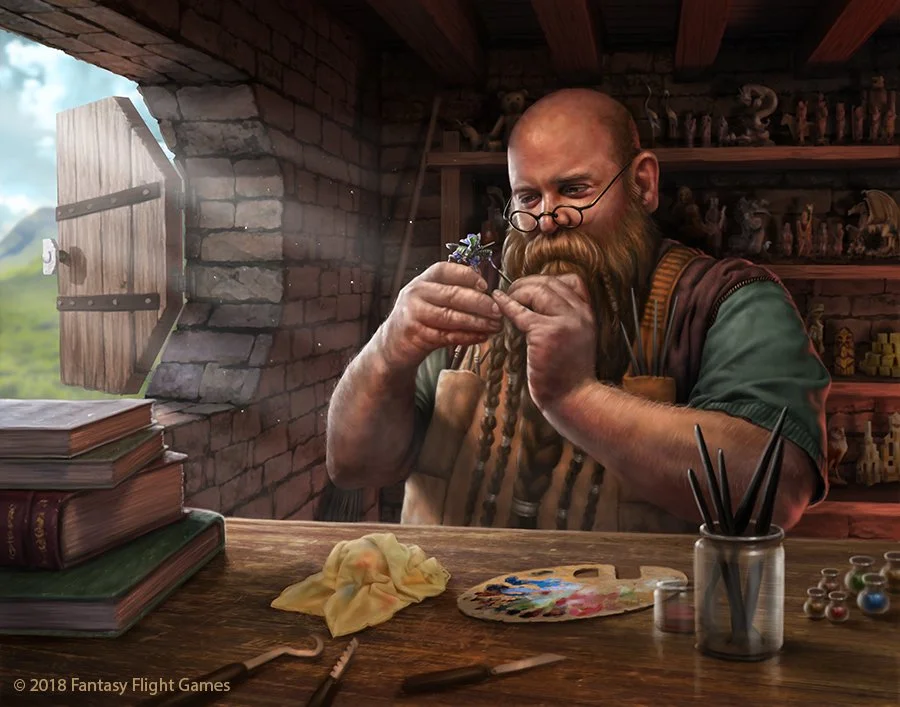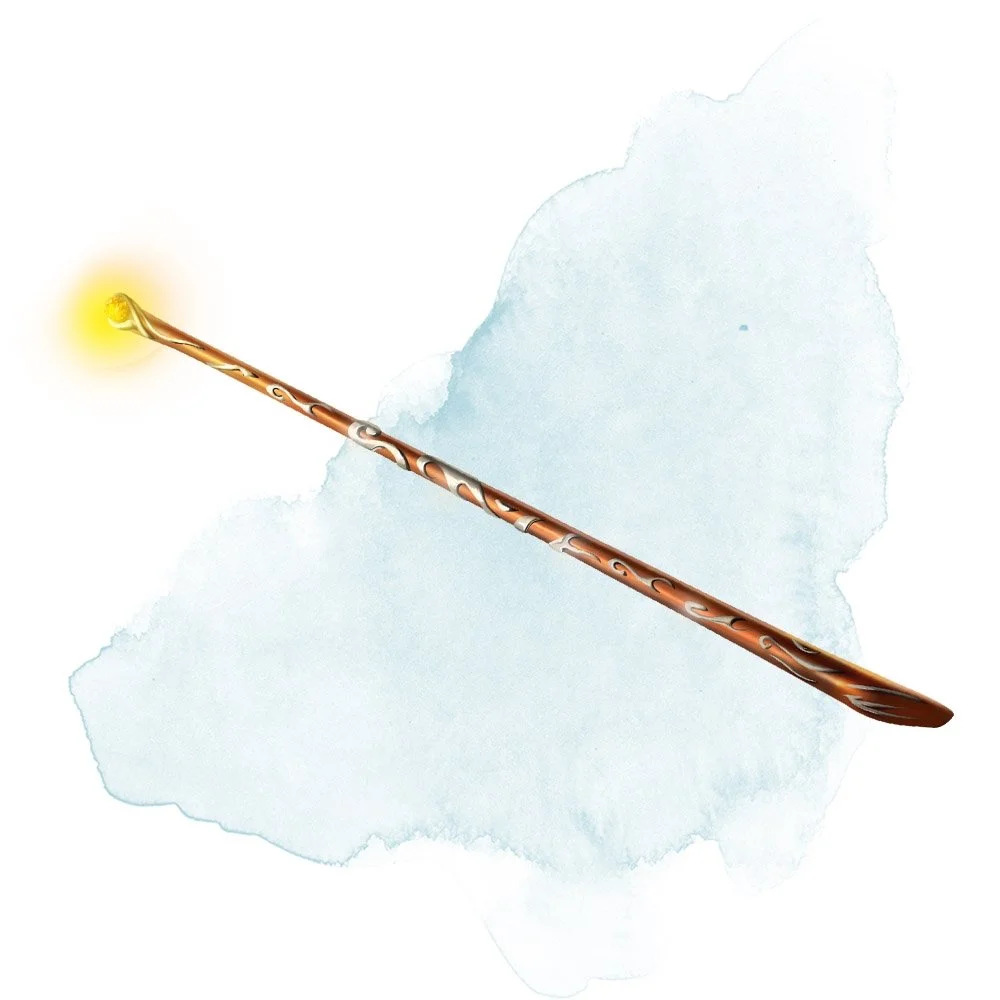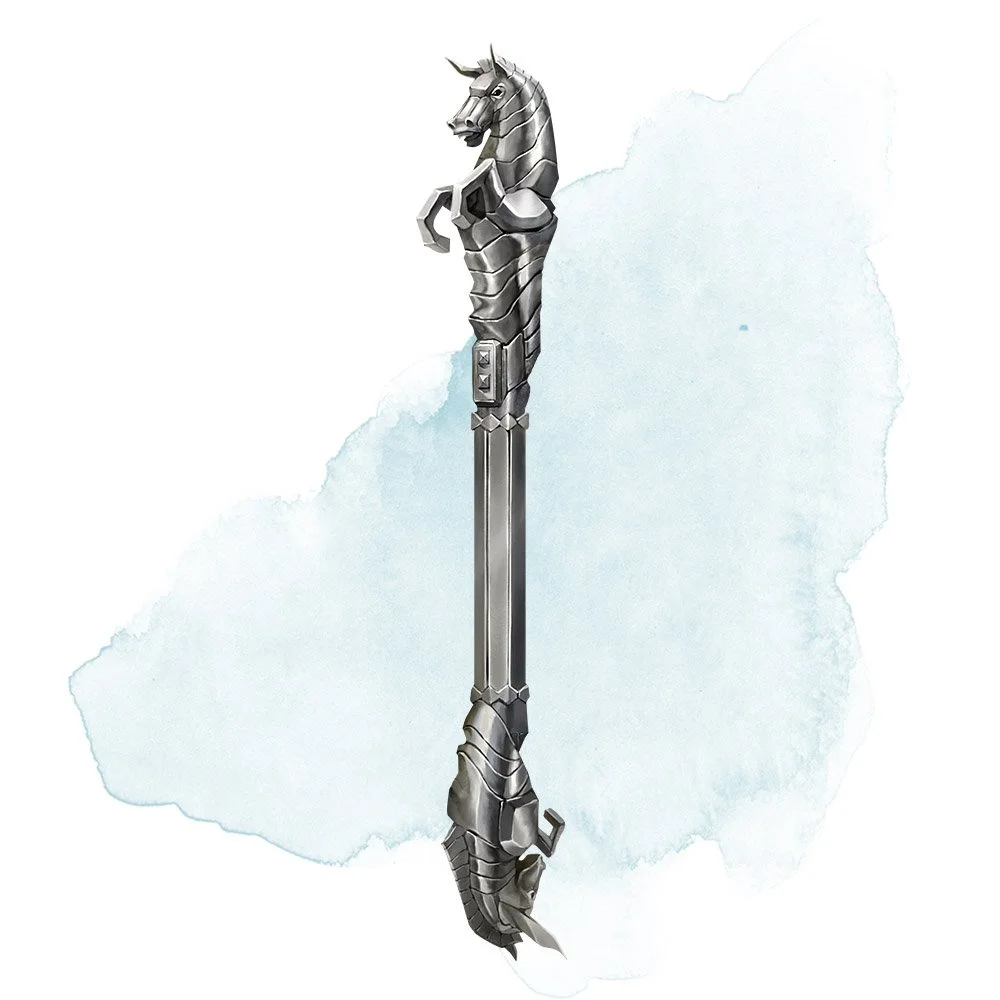Creativity and Making Good Magic Items in D&D
Were the man relieving himself against the back wall of the tavern soberer, he might have noticed a translucent eye pop into existence behind the adjacent shop. The eye peered around, taking a more extended look at the drunk, and then vanished as suddenly as it had come. The door to the shop cracked open, and a red-haired halfling woman stepped out, dropping a monocle into one of the pouches and stepping out spryly, locking the door behind her. Rubbing his eyes, the drunk turned, but the halfling was already well past him, and somehow she seemed to evade his eyes, her cloak helping her to blend into the shadows.
Ren sighed as she took in the crisp cold night's air. She loved her craft in the workshop, but she wished she could be a bit more open than she was the genius behind "Marvelo's Magic Emporium." Rosaline was right though, it was better than Garrik, with his white beard and the look of a wizened old mage, would play the part better. She'd like to break those preconceptions, prejudices, and sometimes outright condescension, but she knew that it was either a battle for those principles or the money. One day, when she had made her fortune, she would set up her own shop to show off her wares.
*** If you just want to hear my tips on how to craft better magic items, jump down to the picture of Dwarf craftsman***
As a boy, I excelled in Mathematics, was good at the Sciences, was terrible at art, and compared to my, often Tiger-mum driven, Chinese friends, not musical (i.e., I wasn't a grade 7 musician in any instrument by the age of 10). This meant that I grew up being categorized and considering myself as "not creative." It was only thanks to a couple of my English teachers who encouraged my creative writing that I believed I had any creative flair at all.
Image Source: https://mathhombre.blogspot.com/2010/09/is-math-creative.html
There is an element to creativity in mathematics, especially at the highest level and even more so in programming. Unfortunately, I had been "pigeon-holed" so early in my life, I failed to recognize that. As a teacher, in analyzing how best to encourage my students in their mathematics, I discovered this creative side in me. I have found that you can exercise your creativity in how you deliver your lessons and the teaching tools you create. Still, since a lot of the job is admin, marking, and encouraging your students to produce good work, it can be frustrating not to have a piece of work that you point to as your own. I have revisited writing over the years and have grown to appreciate this more and more as a necessary creative outlet: writing film reviews, travel reviews, observations on life, and eventually arriving at these blog posts.
I've drifted in and out of the roleplaying scene, only running and playing the occasional game through my 20s and 30s. Again, rediscovering D&D as a tool for education, I've found a way to connect and share my passions with students. I have seen how much it encourages creativity in both them and myself. As a mathematics teacher, teaching the more "creative" subjects has always seemed a little bit of a mystery to me. I've spent the last few years really examining my own teaching and learning styles. In a combination of how I teach in the classroom, how I interact with my students outside school, and my own learning journey, I have concluded that there is a lot of common ground with teaching mathematics. I'm going to touch on just a few in this article.
The first step is finding inspiration. Dungeon Masters, like all creative people, find their inspiration from all sorts of sources. I was listening to a podcast the other day, and one Dungeon Master was commenting how she found inspiration from the fantastic poetry she reads. Ask on any forum, and they will inundate you with fantasy authors you should read and incredible TV series that you should watch. There is also art - see my social media for regular spotlights on amazing fantasy artists, comics, and music that are there to inspire.
The second step is to find motivation. Inspiration to create is not just about finding sources of inspiration. It's also about encouraging yourself the desire to create. That may sound strange, but consider the writers who take a "writing holiday" and isolate themselves in beautiful locations with no distractions. They are actively working to find that motivation. Many use music to get themselves "in the mood." I encourage my students to set a specific time to sit down and revise mathematics. I tell them that it helps to have a separate space to work. Don't work where your Playstation/ Computer/ Bed is, and for goodness sake, put away your mobile phone! Perhaps go to the library. You've probably heard all of this from your teachers. A lot of the motivation for Dungeon Masters creating things comes from loving the game, wanting to build your own NPCs/ campaigns/ monsters/ magic items/ world, and having a great group that you want to share this with. I haven't met any Dungeon Masters who have played for a time who haven't turned their hand to creating things for their games, and you can see so many asking for advice in the forums.
The final way to encourage creativity that I will touch on today (there are more coming in the next part) is practice. This is the most important one for mathematics. The rare genius mathematician, of whom, in the over 20 years I have taught, probably I can count on one hand, can apply mathematical theory immediately to complex contextual questions without needing to practice. Even those students need to try one or two questions to ascertain that they fully understand and apply the theory. The same is true for great creative projects. If you look at the great artists through the centuries, you can see that most had an incredible number of sketches and practice material. "Practice makes perfect," they say.
Image Source: https://www.deviantart.com/r-valle/art/Dwarf-Craftsman-775517289
Crafting Better Magic Items
So, I was requested to answer the question: "How do you make a good magic item in Dungeons and Dragons?" on a particular forum site. My answer seemed to go down well, so I thought I'd repeat and expand upon it here.
There are so many amazing creators that you can find on the internet. I post a weekly example of homebrew magic items and spotlight these creators on my social media. The problem with the homebrew magic items is that the rarity of a magic item seems to be inverse to how common they are. You can't swing a cat for finding an overpowered legendary item. They are usually created by a fresh-faced new Dungeon Master, and I can understand why. It's an easy thing to do because Dungeon Masters get excited about creating really cool magic items. It's a bit like a small child drawing a spaceship. They draw their spaceship with so many guns and lasers that there's no space for anything else. While I'm not about to go critiquing the spaceships drawn by little children and making them cry, it's just a bit unrealistic, isn't it? I mean, where do you keep the ammo? How do you power that massive laser that's bigger than half your ship? And have you ever thought about the recoil?). Little children, while they are often geniuses in creativity, have a minimal grasp of the laws of Physics. But why should they?
"It's fantasy!" I can hear the internet moaners cry!
I'm talking about Dungeon Masters now, not children. I often hear complaints about how Dungeon Masters struggle to challenge their players and that the challenge ratings don't make sense. Well, if you hand out magic items like candy and give them overpowered magic items, it's not surprising that you are going to struggle to challenge them. It also makes for an easy TPK (Total Party Kill). Your players now have powerful attacks, and so you are matching them against powerful monsters and deadly traps, and those are not matched by their own hit point levels and magic protections. Yes, balance is a myth in D&D, but the game is designed so that hit points and protections generally match the level of the attacks. When we grow up, we learn to draw better spaceships, and as Dungeon Masters, when we have more experience, we learn to have more sensible, more nuanced magic items.
So how do you create sensible magic items?
The first thing to do is to take a look at existing items and measure what you've got against them. The more experience (practice) you have as a Dungeon Master will help. You will learn to judge how you might give your players items that help them but don't overpower them. Most inexperienced Dungeon Masters, myself included once upon a time, will throw magic items at their players, either in an attempt to win their favour or because they think that having lots of epic magic items will make the game more fun. I actually find that often the opposite is true, and the DM is scrabbling to try and make the encounters powerful enough to make it interesting. That's why I run a relatively low magic game; the players get no major magic items in tier 1 (levels 1-5) and only get legendary items in the highest tiers. The exception to these is items that increase in power when the players level up or cursed items (back to that later).
Here's my simple advice: when making a magic item, I like to think of what it is I want the item to do, then I think what is it that the creator of the magic item would actually need.
For example, let's take a wand of fireballs. The wizard would love a wand that just casts tons of fireballs whenever he wants, but in reality, he doesn't have the power or resources to create a wand with an infinite supply of Fireballs. Even magic creation has to have rules and limits. Fireballs are powerful enough. Think about what he would figure that he actually needs. He would probably only need one or two per encounter (especially considering that he has his own spells and other tools), and certainly wouldn't expect more than two encounters in a day. Perhaps he could create a wand that has 3 charges and recharges one charge per day? He's not going to think that he's going to have more than one day full of difficult encounters, and if there was a terrible day, then he would hide for several days to recharge the wand.
Image Credit - WotC
I also like my players to be more innovative in their thinking, so magic items that can be used creatively are great. I prefer low magic settings because it forces the players to get really inventive. Single-use items cause the players to think about when they need them, but be careful of hoarders! Basic non-magic items like simple iron spikes, the ten-foot pole, a crowbar, or 1000 ball bearings have a plethora of uses depending on the player's creativity, which is why spending a few levels without any magic items is excellent. I've heard quite a few very experienced players say that the most exciting levels to play at are actually the first couple of levels where death is very imminent, and you have to work really hard and creatively to make sure that you don't die.
The immovable rod is precisely the kind of magic item that I like. With two, they could climb into thin air. One can block a door or trap the head of a monster. Vox Machina in Critical Role decided to jump into the belly of a dragon and use their immovable rod to try to ground the creature. A bit more imagination might have allowed them to have a rig connected to the rod to immobilize the beast. The possibilities are only limited by your imagination.
Image Credit - WotC
I heard about a Dungeon Master who let their player have really sticky rice balls. They were so sticky that the rogue could use them to climb walls. That's something different that makes the players think and innovate, thereby encouraging their creativity and critical thinking skills. How about an expanding metal rod? Think about what you could do with a coin, that given a word, expands into a staff with great force. I know that some of you are already imagining pretty gruesome uses for it.
I also love giving my players cursed items. These also limit the power of the players and force them to think twice about whether they want to suffer the consequences of the curse or come up with creative ways to get around the curse.
I posed the question: "What interesting magic items would come from a swamp hag?" in an online forum. Someone suggested a jar of mud, which I doubt was a Pirates of the Caribbean reference. So, I created a magic jar of mud from this one suggestion. The Jar of Mud magic item was born! Twice daily, the owner can throw a clod of mud, and a small mud man (not very powerful) would appear. Great for distractions, flanking, and sneak attacks for the rogue. The curse, however, was that Shambling mounds would start appearing to attack the party. The party would probably have no idea of the link for a while, not until the mounds also start appearing in towns and with more frequency following then. If they investigate, it turns out that the mud was stolen from the Shambling Mound sacred breeding ground, and the mudmen are actually baby Shambling Mounds. The curse on the items offsets the power gained and may put the players in additional sticky situations. The players can perhaps abandon the cursed item, or the quest to fix the curse can perhaps lead to a whole other campaign… or maybe just ongoing sidequests as you see fit.
Anyway, have fun. You all can be incredibly creative, and you can all improve your creative skills.
Find your inspiration; search for your motivation; avoid distractions and practice! You learn best by doing. Talk to your players if you make a mistake and need to take away or change what you've given them. Nerfing has an undeserved negative reputation. You'll do better next time. This is how we learn.
Ren wrinkled up her nose as she entered the poorer district that she lived in. "One day soon..." she thought to herself. She missed the days of high adventuring when Ellowyn would demand only the best taverns, and often, they didn't have to pay at all by providing the entertainment.
She approached a large three-story building full of apartments, tossed what looked like a coin on the floor before stepping on it with her steel boots. Taking just a moment to look around to make sure nobody was looking, Ren positioned herself right with practiced ease and then whispered, "Naik." Transforming into a metal staff, Ren sailed through the air and deftly alighted on the ledge outside a second-floor window. She whispered "Turan" as she reached down the deceptively light metal staff magnetically stuck to her boot.
She shook her head as she remembered the number of clients who wanted flying brooms and carpets. Her magic staff - she let Rosaline come up with the fancy names, lifted her up to 60 feet in the air if she needed to. There were very few times where she could have used flying instead, and she had often had to jam the metal staff into closing passageways, used it to surprise a crouching enemy, and had once even left it on the seat of a gloating evil cleric...
As the staff returned to the size of a coin, she slipped it off and returned it to her pocket. Again, looking around, she cracked open the window and whispered "Paduan" into the dark living space. A simple "Caya" lit various lights around the room as she then stepped into her home.
Despite the silence, Ren sensed a presence. She had made sure that she didn't because so reliant on her magic that she forgot to use those. She spun, her hammer in one hand and her other reaching for the wand tucked in her belt.
"You should stop using our old party name for your deactivation word. Far too predictable..." as a cloaked figure stepped out of the shadows.
"No hugs for an old friend?" The gentle cultured voice accompanied the figure lifting back his hood to reveal a grinning feline face.
Many thanks for reading,
Sam, The Educational DM (Twitter: @DMEducational )
If you like our articles, love Homebrew, and are looking for a fun and active community to talk about all things D&D, consider supporting us on Patreon. Below are some of the benefits we offer:
Access to our Homebrew Horde with over 300 items and counting!
Vote on upcoming Deep Deep topics
Monthly online one-shot adventures
Early access to Deep Dive and Rewind Articles
Even more Homebrew in our Magic Item Monday and Monster Thursday series
Exclusive audio from our new YouTube Deep Dive series







